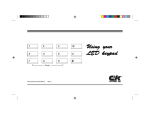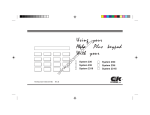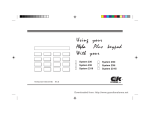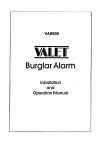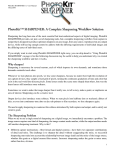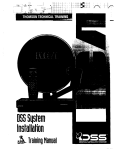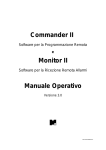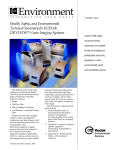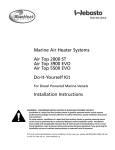Download C&K Systems 236 Keypad User Manual
Transcript
y om .m .c rm al a .e w w w System 236 P/N 5-051-371-00 Rev D System 236i om .m y Thank you for purchasing this C&K alarm system. Your system is one of the most powerful and advanced alarm systems on the market today, designed to provide you with years of reliable operation. rm .c This manual explains how to operate your alarm system. Basic operating instructions are also printed on the label inside your keypad(s) door. If you have monitoring questions or in cases of accidental alarms, call: .e al a If you have any questions or need help with your alarm system, call: ______________________________________ (Monitoring Station Name) w w ______________________________________ (AlarmCompanyName) w ______________________________________ ______________________________________ When calling the monitoring company, know the following: My Account Number is: _______________________ 2 My Password is: ____________________ .c om .m Door chime / Keypad tones ...........................23-24 Testing your system ............................................ 25-27 Telephone trouble ................................................ 28 Smokedetectorplacement .................................. 29 Emergencyevacuation ........................................ 30 Definitions ............................................................ 31 Limitations of your alarm system .........................32 Keypad operations ...............................................33-35 Test Procedure Index .......................................... 36 Zone description list .............................................37 FCC Notice .......................................................... 38 Industry Canada .................................................. 39 w w w .e al a rm Gettingacquainted ............................................... 4-5 What the lights mean ........................................... 6-7 What the sounds mean ........................................ 8 Arming the system ............................................... 9-15 Bypassing zones ........................................... 14-15 Arming options ..................................................... 16 Disarming the system .......................................... 17 After an alarm ...................................................... 18 Options ................................................................. 19-24 Changing a PIN ............................................. 20-21 Deleting a PIN ............................................... 21 Resetting smoke detectors ........................... 22 y Table of contents 3 y rm .c om .m What your alarm system is... Your alarm system is made up of a control panel and several detection devices like motion sensors, magnetic contacts, and so on. Specific areas of detection are called zones. Zones can be programmed to have different characteristics. Some zones may be 24-hour zones, that is, they remain armed even when the alarm system is off. Zones used for fire detection, for example, are always 24-hour zones. In addition, some zones can be programmed to allow bypassing. When you bypass a zone, you temporarily remove it from the alarm system. Always remember, however, that bypassed zones are not protected. w w .e al a How your alarm system works... When a detection device is triggered, the status of its zone goes from normal to FAULTED. If armed, the control panel responds by reporting an alarm condition on site --- flashing keypad lights, sounding bells --- and if programmed, by transmitting an alarm signal over the telephone wires to a central monitoring station. The monitoring station then dispatches the appropriate authorities. w Some of your system's operations require you to enter your personal identification number (PIN) on the keypad. These include ARMING and DISARMING. Along with its many other features, your system can be programmed to ARM INSTANTLY or to ARM WITH TIME DELAY (i.e., after giving you time to leave the premises). 4 y om .m Each alarm system in the 23XX family is designed to meet the specific needs of a variety of applications. The System 236 is designed for applications requiring protection of six zones. rm .c Some of the available features of your alarm system are also optional, and will only be installed if appropriate for your installation. In addition, some system features will require you to enter your personal identification number (PIN). al a As you read through this manual, watch for boxes like these: OPTION INSTALLED PIN REQUIRED .e . If an optional feature has been installed in your system, its OPTION INSTALLED box will be checked. w w . If a feature of your system requires you to enter your personal w identification number, itsPIN REQUIRED box will be checked. 5 y off on steady on steady FAULTED ZONE WHILE DISARMED off SYSTEM IS ARMED (ALL PROTECTION ON) off* SYSTEM IS DISARMED (ALL PROTECTION OFF) on* SYSTEM IS ARMED WITH DELAY ZONES CONVERTED TO INSTANT PERIMETER ARMED WITH DELAYS INTACT REMARKS Power fail. System on battery. Ready to arm. on steady .e al a rm SYSTEM IS READY (ALL ZONES NORMAL) 6 ARMED SERVICE ZONES LIGHT LIGHT LIGHTS .c AC FAILURE READY LIGHT om .m P OWE R LIGHT *Ready light will be on until system is armed. w w on steady One or more zones are faulted. *Ready light is on if all zones are normal. off slow flash Armed with slow flash on steady w off slow flash* 7 #. Armed with 4 #. *Flashing zones are bypassed. PERIMETER ARMED WITH DELAY ZONES CONVERTED TO INSTANT ARMED SERVICE ZONES LIGHT LIGHT LIGHTS y READY LIGHT slow flash slow flash slow flash ZONE BYPASSED slow flash WATCHDOG RESET w w w BELL FUSE FAILURE slow flash on* al a slow flash .e ZONE(S) IS OR WAS IN ALARM COMMUNICATIONS FAILURE PROGRAMMING MODE slow flash rm .c ZONE TROUBLE LOW BATTERY om .m P OWE R LIGHT slow flash REMARKS slow flash* Armed with 4 7 #. *Flashing zones are bypassed. slow flash Service and zone in trouble. Flash at the same rate. fast flash An alarm has occurred on this zone. *Armed light is on if the system is armed. slow flash Ready and bypassed zone flash at the same rate. on steady Call for service. on steady Call for service. slow flash Panel has reset itself. System OK. To reset the Service Light, press * 1 #. fast flash Call for service. slow flash System is in programming mode. 7 y MEANING . system armed or disarmed . successful central station test or battery test . wrongPINnumberentered . invalidfunction . unauthorizedcommandattempted . error changing PIN number . entrydelaytime . exit delay time . doorchime . zone faulted during walk-test . zone programmed for chirping bell or siren is in alarm . zone programmed for steady bell or siren is in alarm . circuit malfunction (trouble on supervised loops only) . zone programmed for pulsed bell or siren is in alarm om .m SOUND 2 beeps (confirmation tones) continuous tone, beeping fast for last ten seconds .e continuous beeping, speeding up for last ten seconds w w w 2secondbeep chirping (1 second on, 4 seconds off) continuoustone pulsed tone (2 seconds on, 2 seconds off) 8 al a rm .c 5 beeps (error tones) y om .m TO ARM THE SYSTEM / AUTO HOME ARMING: Make sure the green READY light is on. . Faulted zones must be cleared or bypassed before the system can be armed. For more .c information, refer to the sectionsBypassing Zones andAfter An Alarm Occurs. . If programmed, the red ZONE lights will automatically turn off after five minutes (as a rm OPTION INSTALLED .e Enter your PIN and push the # key. w w . Your PIN number is four digits long. . Don't pause for more than 5 seconds while entering the digits or the control panel will reject your PIN number. w PIN REQUIRED al a security measure). Pressing any key on the keypad will turn the ZONE lights back on. . If you make a mistake while entering your PIN number, the keypad will beep five times. After the fifth beep, enter your PIN number again. Make sure the red ARM light comes on. . The keypad will beep twice to confirm that the system is armed. 9 y OPTION INSTALLED om .m Exit through any TIME DELAY DOOR within seconds. . The exit delay time can be programmed from 10 seconds to 150 seconds. . If the EXIT PRE-ALARM option is installed, the keypad will beep slowly until 10 seconds before the delay time expires, then rapidly for the last 10 seconds. .c . Once the exit delay time has expired, the keypad will beep twice to confirm that the al a TheAUTO HOME ARMINGoption enables the system to automatically bypass interior zones if you arm the system but do not leave the premises. The perimeter zones will be armed and the entry delay will remain intact. w .e OPTION INSTALLED rm system is armed. With this option installed, arm the system (enter your PIN and push the # key). w . If you do not exit before the exit delay time expires, the system will automatically arm w perimeter zones and bypass interior zones. . If you exit through an exit delay door, the system will automatically arm interior and perimeter zones. The rest of the ARMING THE SYSTEM section explains how to bypass zones before arming the system, as well as certain arming options our installer can install. However, it's important for you to remember that no matter how your system is programmed, you will always disarm it in the same way: enter your PIN, then push the # key. 10 y om .m INSTANT ARMING Instant Arming converts all time delayed zones toINSTANT zones. .c Make sure the green READY light is on. rm Enter your PIN (if required), push the key, enter the digit "7", then push the # key. al a PIN REQUIRED 7 w .e . The keypad will beep twice to confirm that the system is armed. . The red ARM light will flash while the system is Instant Armed. w w CAUTION: When the system is Instant Armed, you will not be able to enter through any perimeter door or walk through any protected area without setting off an alarm. . Home Arming or bypassing interior zones will allow you to move about freely inside the premises while the system is armed. Refer to the next three sections: HOME ARMING, INSTANT HOME ARMING, and BYPASSING ZONES. OPTION INSTALLED . Exit Delay Disable (see page 16). 11 y om .m HOME ARMING Home Arming arms perimeter zones, while bypassing interior zones. Enter your PIN (if required), push the key, enter the digit "4", then push the # key. al a PIN REQUIRED rm .c Make sure the green READY light is on. 4 w armed. w w .e . The keypad will beep twice to confirm that the system is armed. . The red ARM light will be on while the system is armed. . Home Arming allows you to move about freely inside the premises while the system is . The red ZONE light(s) of bypassed zones will flash slowly. . You can enter the premises without setting off an alarm through any time delay entry. (Don't forget to disarm the system after entering!) OPTION INSTALLED 12 . Exit Delay Disable (see page 16). y om .m INSTANT HOME ARMING .c Instant Home Arming arms the perimeter zones and bypasses interior zones. Entry time delays are converted to INSTANT. rm Make sure the green READY light is on. al a Enter your PIN (if required), push the key, enter the digit "7", the digit "4", then push the # key. 7 . The keypad will beep twice to confirm that the system 4 4 OR 7 w is armed. w .e PIN REQUIRED w . The red ARM light will flash while the perimeter zones are Instant Armed. . The red ZONE light(s) of bypassed zones will flash slowly. CAUTION: When the system is Instant Home Armed, you will not be able to enter through any perimeter door without setting off an alarm. OPTION INSTALLED . Exit Delay Disable (see page 16). 13 y om .m BYPASSING ZONES .c This procedure allows you to bypass one or more zones while your system is DISARMED1. (See NOTE pg. 15) al a rm NOTE:System programming determines which PINs can bypass zones, also which zones can be bypassed. To learn if a zone can be bypassed, see the ZONE DESCRIPTION LIST on page 37. Enter your PIN (if required). OPTION INSTALLED Push the key, enter the digit "2", enter the zone to be bypassed, then push the # key. w OPTION INSTALLED 14 2 ZONE # w w .e PIN REQUIRED OR Push the key, enter the zone to be bypassed, then push the # key. ZONE # y om .m . To indicate that zones are bypassed, the zone LED for the bypassed zone will flash slowly. 1 NOTE: Zones can be also be bypassed by remote programming. When remote programming is used, the system can either be armed or disarmed. al a rm .c . The procedures for adding a bypass and removing a bypass are identical. . To remove a bypass: OR w w w .e Enter your PIN, push the key, enter the digit "2", enter the zone from which the bypass is to be removed, then push the # key. Enter your PIN, push the key, enter the zone from which the bypass is to be removed, then press the # key. NOTE: Disarming your alarm system REMOVES all bypasses. 15 y GOOF-PROOF ARMING If any zone other than a 24-hour zone is faulted (open window, malfunctioning sensor, etc.), your system will not arm. You will not be able to arm the system until the faulted zone is cleared or manually bypassed. FORCE ARMING al a OPTION INSTALLED rm .c OPTION INSTALLED om .m Your alarm system has been programmed for one of the following two arming types: w w w .e Any zone (except for 24-hour zones) that is violated during the EXIT DELAY time will automatically be bypassed until the system is disarmed. Warning: bypassed zones are not protected. OPTION INSTALLED 16 EXIT DELAY DISABLE If this option is installed, the exit delay will be eliminated when arming your system using Instant Arming (page 11), Home Arming (page 12), or Instant Home Arming (page 13). y om .m TO DISARM THE SYSTEM: Enter only through a TIME DELAY door. rm .c seconds before the delay time expires (or the panel is disarmed), then beep rapidly for the last 10 seconds. .e al a Enter your PIN within seconds and push the # key. w Make sure the red ARM light on the keypad goes off. . If the ARM light does not go off, wait for the keypad to beep five times, then enter your PIN again. w PIN REQUIRED . If the ENTRY PRE-ALARM option is installed, the keypad will sound constantly until 10 w OPTION INSTALLED . The keypad will beep twice to confirm that the system has been disarmed. . All bypasses are removed. 17 PIN REQUIRED y om .m AFTER AN ALARM OCCURS: Enter your PIN and push the # key. rm .c . This will silence the bell/siren and disarm the system. . The red ZONE lights on the keypad will flash fast to help you remember where the al a violations occurred. w .e If this is a false alarm and no emergency response is needed, call our central station IMMEDIATELY at to cancel the alarm. w w . Write down the number of the faulted zones to help us service you. Clear the alarm memory and red ZONE lights by pushing the key, entering the digit "1", then pushing the # key. 18 1 y 24-HOUR MONITORING om .m OPTION INSTALLED rm POLICE/PANIC KEY When this option is installed, holding down the key for three seconds will trigger an alarm. The keypad will beep twice to confirm the alarm condition. w DURESS ALARM (Available on Systems 236i ONLY) Should an intruder force you to turn your security system on or off, you can send a silent DURESS signal to our central station by entering User Code 6 - a code designated exclusively for a DURESS signal. Your system will appear to be operating normally. There is no indication of an alarm condition. w OPTION INSTALLED w .e al a OPTION INSTALLED .c With this option installed, your alarm system will transmit alarm signals to our central station. 19 y om .m CHANGING A SYSTEM 236 USER PIN User 1 can use his Master PIN to change the PINs of Users 1 - 6. .c Enter your Master PIN, push the key, enter the digit "0", then push the # key. rm MASTER PIN REQUIRED 0 al a . The READY, SERVICE, and ARM lights will flash slowly. w w .e Enter the User number (1 - 6), and push the # key. w Enter that User's new PIN and push the # key. . The new PIN must be four digits long. 20 USER # y om .m Enter the new PIN again and push the # key. . If the new PIN is accepted, the keypad will beep twice. If you make a mistake while .c programming, or if the system rejects the new PIN, the keypad will beep five times. Try again. rm . If no key is pressed for 5 minutes, the system will automatically exit the programming al a mode. w .e Exit the programming mode by pushing the key, then the # key. w Make sure the new PIN works. w After leaving the programming mode, Arm and Disarm your system to ensure that the new PIN functions properly. DELETING A SYSTEM 236 USER PIN User 1 can use his Master PIN to delete the PINs of Users 2 - 6. Follow steps 1 through 4 for Changing a User PIN. In steps 3 and 4 enter four zeros in place of a new PIN. 21 y om .m RESETTING SMOKE DETECTORS When a smoke detector is triggered, the red ZONE light of the zone where it's located will come on, and the bell/siren will sound. Before you do anything else, evacuate the building. Don't go back inside until you are sure it's safe. When it's safe to do so, you can reset the smoke detectors by doing the following: rm .c OPTION INSTALLED 6 2 w STANDBY BATTERY Should there be a loss of AC power, the green POWER light on the keypad will go out, and your alarm system will switch to its standby battery. If an AC power failure lasts for more than 15 minutes, the system will send a signal to the central station (if programmed to do so). w OPTION INSTALLED w .e al a Push the key, enter the digit "6", the digit "2", and push the # key. . The standby battery should be replaced every four to six years with a rechargeable 12 V 6.5 Ah sealed lead-acid battery (such as C&K Model 1265). 22 y om .m DOOR CHIME When this option is installed, the keypad will beep for two seconds each time a designated zone is faulted. .c To turn the door chime on and off (for all keypads installed): Push the key, enter the digit "5", then push the # key. al a rm 5 .e KEYPAD TONE DISABLE w w You can disable the sounds the keypad makes for a variety of functions. These functions include: KEYPAD FEEDBACK (the keypad beeps everytime you press a key), EXIT PRE-ALARM tone (exit delay countdown), ENTRY PRE-ALARM tone (entry time delay countdown), and CONFIRMATION/ERROR tones (see pg. 6). w OPTION INSTALLED To turn the KEYPAD FEEDBACK on and off: Push the key, enter the digit "5", the digit "1", and push the # key. 5 1 23 y om .m KEYPAD TONE DISABLE (Continued) al a rm .c To turn the ENTRY/EXIT PRE-ALARM tones (entry/exit delay countdown) on and off: Push the key, enter the digit "5", 5 2 the digit "2", and push the # key. To turn the CONFIRMATION/ERROR tones on and off: w w w .e Push the key, enter the digit "5", the digit "4", and push the # key. 24 5 4 y om .m LOCAL SYSTEM TEST This option allows on-site testing of each zone in your system. .c To initiate the LOCAL SYSTEM TEST: Enter your PIN (if required), push the key, enter the digit "6", the digit "0", then push the # key. al a rm PIN REQUIRED . Once the keypad lights go out, the system will be 6 0 w . w w .e ready for testing. Walk through the areas protected by motion sensors; open and close protected doors and windows. Each time a zone is faulted, its corresponding red ZONE light on the keypad will begin flashing, and the keypad will chime. To exit the system test, push any key. WARNING: Your alarm system will not report alarms during the LOCAL SYSTEM TEST. 25 y STANDBY BATTERY TEST om .m OPTION INSTALLED Your alarm system can be programmed to automatically test its standby battery every 24 hours. During the test, AC power is turned off in order to monitor the battery under load. rm .c . To manually test the standby battery, push the 6 4 al a key, enter the digit "6", the digit "4", then push the # key. .e . The standby battery test takes 2 minutes. During the test, the POWER light will be off. . If the battery is okay, the keypad will beep twice. BELL/SIREN TEST w OPTION INSTALLED w w If the battery is low or dead, the POWER light will flash slowly, the SERVICE light will be on steady, and the keypad will beep five times. PIN REQUIRED 3 To test the bells/sirens in your security system: Enter your PIN (if required), push the key, enter the digit "6", the digit "3", then push the # key. . The bell/siren and keypads will sound for 3 seconds. 26 6 y CENTRAL STATION TEST om .m OPTION INSTALLED rm .c This option tests the reporting capability of your system by sending a test message to the central station. Weekends are the best time for the CENTRAL STATION TEST. To schedule one, call our central station at: al a CENTRAL STATION .e w w . If the test message was successfully transmitted to 6 1 w PIN REQUIRED To initiate the CENTRAL STATION TEST: Enter your PIN (if required), push the key, enter the digit "6", the digit "1", then push the # key. the central station, the keypad will beep twice. . If the test message was not successfully transmitted to the central station, the keypad will beep five times, and the SERVICE light will flash fast. Call our Service Department for assistance. 27 y om .m IF YOU HAVE TELEPHONE TROUBLE: . rm The phone jack is located .c First, unplug the control panel from its telephone jack to determine if the alarm system is causing the trouble. .e al a If the trouble goes away when you unplug the control, callus for service. If you still have telephone trouble after unplugging the alarm system, plug the system back in, then call yourtelephone company. w w w NOTE: If your telephone system is serviced, make sure to test your alarm system to insure that it has not been disconnected from the telephone network. 28 y w KITCHEN DINING ROOM w BEDROOM BEDROOM LIVING ROOM KITCHEN LIVING ROOM BEDROOM BEDROOM Place detectors near top of stairwells Place detector near all sleeping areas BEDROOM BEDROOM w BEDROOM DINING ROOM FAMILY ROOM .e Best residential detector placement between bedrooms and the rest of the house al a rm .c om .m We subscribe to the recommendations for the number and placement of smoke and/or heat detectors found in the National Fire Protection Association'sStandard #72, Chapter 2(N.F.P.A. Batterymarch Park, Quincy, MA 02269). For the best early warning, fire detection devices should be installed in all rooms and areas of the premises. A smoke detector should be installed in each separate sleeping area, in the vicinity of bedrooms. (In new construction, a smoke detector shall be installed in each seperate sleeping room.) Heat or smoke detectors should be installed in living rooms, closets, utility and storage rooms, basements, and attached garages. = SMOKE DETECTOR C = CONTROL S = SOUNDER K = KEYPAD BEDROOM BEDROOM BASEMENT 29 om .m y Every household should establish and regularly practice an escape plan in the event of a fire. The following steps, recommended by the National Fire Protection Association, can be used as a guide in developing your own emergencyplan. . Establish a meeting place outdoors, away from the house, where . Escape quickly. But don't panic. . Before you open a door, check to see if it's hot. If it is hot, don't al a rm the bedrooms, since most fires occur at night when everyone is asleep. One escape path should lead to a door that permits normal exit from the house. The other may be an easily opened window (used if the primary escape path is blocked). everyone can gather and account for those missing. Choose someone to notify the authorities. Choose someone to ensure that nobody returns to the house. Many die going back inside. .c . Plan on your detector or alarm system sounders waking all occupants. . Determinetwomeansofescapefromeachroom,especially . Sketch a floor plan, showing doors, windows, stairs, and rooftops .e that can be used for escape. Indicate escape routes for each room (see examples below). Post copies of the sketch in each room. Remember to keep all escape routes free from obstruction. w . Keep all bedroom doors shut while the occupants are asleep. open it. Use an alternate escape route. Even if the door is cool, use your shoulder to open it cautiously. Be ready to slam it closed if heat or smoke rushes in. . When moving through a smoky area, stay as close to the floor as possible. Crawl and hold your breath. KITCHEN w w This will prevent deadly smoke from entering the rooms while you escape. DINING FAMILY ROOM BEDROOM SAMPLE SECOND FLOOR SAMPLE FIRST FLOOR BEDROOM LAUNDRY 30 BATH LIVING ROOM BATH BEDROOM y ALARM A condition that occurs when the detection devices in a zone are triggered after the system is armed. om .m EXIT DELAY Once the system is armed, the time you have to exit the premises through a DELAY DOOR (before an alarm occurs). The delay time is programmable from 10 seconds to 150 seconds. al a rm BYPASS To take a zone out of the circuit. Bypassing malfunctioning zones allows the rest of the system to be armed. Bypassing interior zones allows freedom of movement inside the premises, while leaving outer zones armed. Bypassed zones are not protected. FAULT A trouble condition that occurs when the detection devices in a zone are violated or mafunctioning while the system is disarmed. .c ALARM MEMORY Alarm conditions are stored in memory until cleared. w w w .e CENTRAL STATION The office that the alarm system calls when there is an alarm. Signals sent to the central station contain information about the nature of the alarm condition, allowing the dispatcher on duty to appropriately respond. ENTRY DELAY The time you have to enter the premises through a designated DELAY DOOR and disarm the panel (before an alarm occurs). The delay time is programmable from 10 seconds to 150 seconds. [Note: if this option is programmed forLong Delay, the delay time will be doubled (from 20 to 300 seconds).] GRADE "A" System that provides supervision of the transmitter or initiating devices (i.e., detection devices and wiring). PERSONAL IDENTIFICATION NUMBER (PIN) The combination used to arm and disarm the control panel, and to access any of the special functions that require a combination. PIN numbers must be four digits long. ZONE One of the protected areas in your premises. 24-HOUR ZONE A zone that is always active, whether the system itself is armed or disarmed. FIRE, POLICE, and EMERGENCY zones are usually 24-hour zones. Alarm conditions on these zones are cleared by entering a valid PIN number. 31 y om .m THE LIMITATIONS OF YOUR ALARM SYSTEM While your alarm system is reliable and sophisticated, it does not offer guaranteed protection against burglary or fire. Any alarm system, whether commercial or residential, is subject to compromise or failure-to-warn for a variety of reasons. These include: Intruders may gain access through unprotected openings or have the technical sophistication to bypass an alarm sensor or disconnect an alarm warningdevice. Intrusion detectors, smoke detectors, and many other detection devices will not operate without power. Devices powered by AC will not work if their AC power supply is off for any reason and their back-up batteries are missing, dead, or improperly installed. Alarm warning devices such as sirens, bells, and horns may not alert people or wake up sleepers if they are located on the other side of closed or partly closed doors. If warning devices are on a different level of the residence from the bedrooms, they are less likely to waken or alert people inside the bedrooms. Telephone lines needed to transmit alarm signals from a premises to a central monitoring station may be out of service, and are subject to compromise by sophisticated means of attack. Smoke detectors used in conjunction with the alarm system may not sense fires that start where smoke cannot reach the detectors, such as in chimneys, walls or roofs, or on the other side of closed doors. Smoke detectors also may not sense a fire on another level of the residence or building. A second floor detector, for example, may not sense a first floor or basement fire. Finally, smoke detectors have sensing limitations. No smoke detector can sense every kind of fire every time. In general, detectors may not always warn you about fires caused by carelessness and safety hazards, like smoking in bed, violent explosions, escaping gas, improper storage of flammable materials, overloaded electrical circuits, children playing with matches, arson, etc. The most common cause of an alarm system not functioning properly when an intrusion or fire occurs isinadequate maintenance. Your alarm system should be tested weekly to make sure all detection devices are operating properly. Your control panel and keypads should be tested as well. Installing an alarm system may make you eligible for lower insurance rates, but an alarm system is not a substitute for insurance. Homeowners, property owners, and renters should continue to insure their lives and property. al a rm .c . . . w w w .e . . . . 32 y om .m For your convenience, the following is a list of the keypad operations discussed in these instructions. KEYS FUNCTIONS Arms and Disarms the system NUMBER (PIN) .c PERSONAL IDENDIFICATION Programs new user PINs (Master PIN required). 1 Clears the alarm memory and Watchdog Reset (Service Light) al a rm 0 .e Bypasses individual zones (PIN may be required). ZONE # w w or w 2 ZONE # 4 4 7 Arms the system with interior zones bypassed (PIN may be required). Converts Entry time delay zones to INSTANT (if programmed to do so), and arms perimeter zones, while bypassing interior zones (PIN may be required). Refer to Instant Home Arming on page 13. 33 Turns the Door Chime on/off (on all keypads). 5 34 y FUNCTIONS om .m KEYS 1 Turns the audible Keypad Feedback on/off. 5 2 Turns the Entry/Exit Pre-Alarm tones on/off. 5 4 Turns the Error tones on/off. 6 0 6 1 6 2 w .e al a rm .c 5 w w Initiates the Local System Test (PIN may be required). Initiates the Central Station Test (PIN may be required). Resets Smoke Detectors. y FUNCTIONS om .m KEYS 3 Initiates the Bell/Siren Test (PIN may be required). 6 4 Initiates the Standby Battery Test. rm .c 6 Converts all time delay zones to INSTANT and arms the system (PIN may be required). Converts Entry time delay zones to INSTANT (if programmed to do so), and arms perimeter zones, while bypassing interior zones (PIN may be required). Refer to Instant Home Arming on page 13. w w .e 4 w 7 al a 7 35 y om .m As required by UL Standard 1023, your alarm system is a Grade "A" system (see definition on page 31). .c Alarm system malfunctions and failures are caused most often by INADEQUATE MAINTENANCE. al a rm Your alarm system should be tested weekly to make sure that all detection devices are working properly. In addition, if your system is being monitored, you should periodically test its ability to transmit signals to our central station. .e These tests should be performed weekly: w w w . LOCAL SYSTEM TEST: Enter PIN (if required), then . CENTRAL STATION TEST: Enter PIN (if required), then . BELL/SIREN TEST: Enter PIN (if required), then . STANDBY BATTERY TEST: Refer to pages 25 - 27 for further information on test procedures. 36 6 0 6 1 6 3 6 4






































